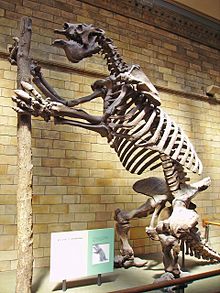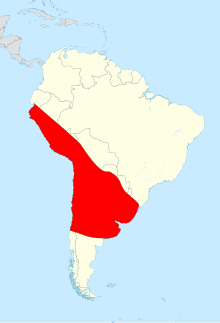
Back بهضم Arabic Megateri Catalan Megatherium Czech Megatherium German Μεγαθήριο Greek Megatherium Esperanto Megatherium Spanish Megaterio Basque بزرگدد Persian Megatherium Finnish
| Megatherium | |
|---|---|

| |
| M. americanum skeleton, Natural History Museum, London | |
| Scientific classification | |
| Domain: | Eukaryota |
| Kingdom: | Animalia |
| Phylum: | Chordata |
| Class: | Mammalia |
| Order: | Pilosa |
| Clade: | †Megatheria |
| Family: | †Megatheriidae |
| Subfamily: | †Megatheriinae |
| Genus: | †Megatherium Cuvier, 1796 |
| Type species | |
| †Megatherium americanum Cuvier, 1796
| |
| Subgenera | |
|
Megatherium
| |

| |
| Map showing the distribution of all Megatherium species in red, inferred from fossil finds | |
| Synonyms | |
| |
Megatherium (/mɛɡəˈθɪəriəm/ meg-ə-THEER-ee-əm; from Greek méga (μέγα) 'great' + theríon (θηρίον) 'beast') is an extinct genus of ground sloths endemic to South America that lived from the Early Pliocene[1] through the end of the Pleistocene.[2] It is best known for the elephant-sized type species Megatherium americanum, native to the Pampas through southern Bolivia during the Pleistocene. Various other species belonging to the subgenus Pseudomegatherium ranging in size comparable to considerably smaller than M. americanum are known from the Andean region.
Megatherium is part of the sloth family Megatheriidae, which also includes the closely related and similarly giant Eremotherium, comparable in size to M. americanum, which was native to tropical South America, Central America and North America as far north as the southern United States. Megatherium was first discovered in 1787 on the bank of the Luján River in Argentina. The holotype specimen was then shipped to Spain the following year wherein it caught the attention of the paleontologist Georges Cuvier, who was the first to determine, by means of comparative anatomy, that Megatherium was a sloth.
Megatherium americanum is thought to have been a browser that fed on the foliage and twigs of trees and shrubs using a black rhinoceros-like prehensile lip. Despite its large body size, Megatherium americanum is widely thought to have been able to adopt a bipedal posture at least while standing, which allowed it to feed on high-growing leaves, as well as possibly to use its claws for defense.
Megatherium became extinct around 12,000 years ago as part of the end-Pleistocene extinctions, simultaneously with the majority of other large mammals in the Americas. The extinctions followed the first arrival of humans in the Americas, and one and potentially multiple kill sites where M. americanum was slaughtered and butchered is known, suggesting that hunting could have caused its extinction.[3]
- ^ a b Saint-André, P. A.; De Iuliis, G. (2001). "The smallest and most ancient representative of the genus Megatherium Cuvier, 1796 (Xenarthra, Tardigrada, Megatheriidae), from the Pliocene of the Bolivian Altiplano" (PDF). Geodiversitas. 23 (4): 625–645. Archived from the original (PDF) on 2013-10-29. Retrieved 14 April 2016.
- ^ Zurita, A. E.; Carlini, A. A.; Scillato-Yané, G. J.; Tonni, E. P. (2004). "Mamíferos extintos del Cuaternario de la Provincia del Chaco (Argentina) y su relación con aquéllos del este de la región pampeana y de Chile". Revista Geológica de Chile. 31 (1): 65–87. doi:10.4067/S0716-02082004000100004.
- ^ Politis, Gustavo G.; Messineo, Pablo G.; Stafford, Thomas W.; Lindsey, Emily L. (March 2019). "Campo Laborde: A Late Pleistocene giant ground sloth kill and butchering site in the Pampas". Science Advances. 5 (3): eaau4546. Bibcode:2019SciA....5.4546P. doi:10.1126/sciadv.aau4546. ISSN 2375-2548. PMC 6402857. PMID 30854426.